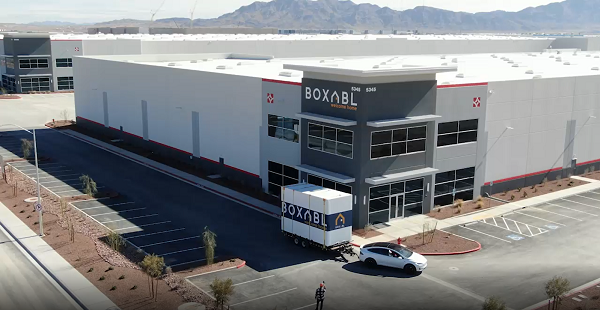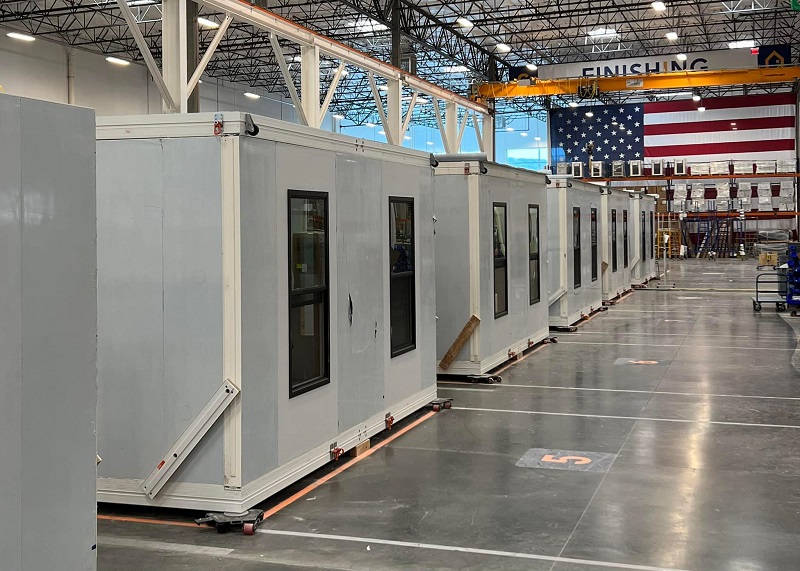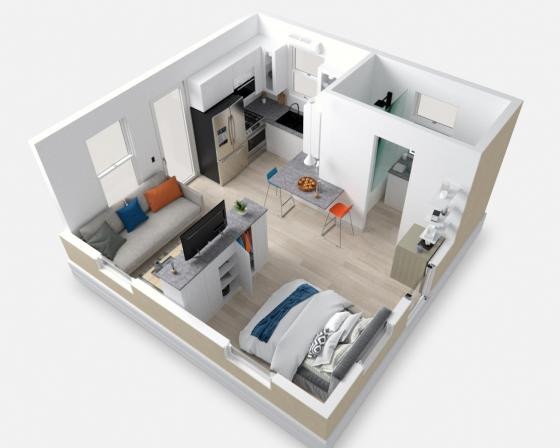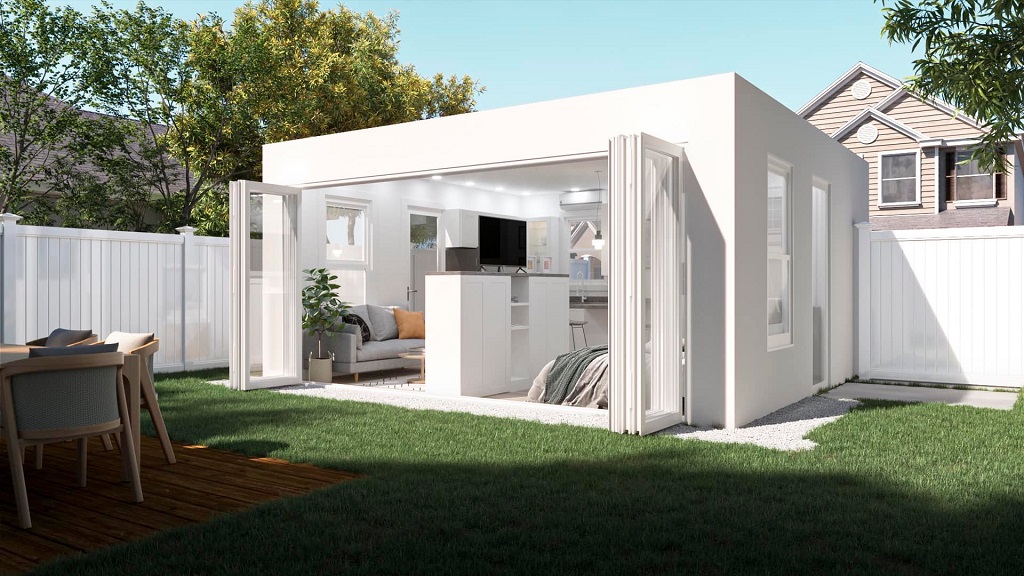Updated: August 5, 2022
Learn how Boxabl is disrupting the residential construction industry by using automation to mass produce affordable housing from ADUs to Tiny Houses to large residential homes, and more.
Boxabl’s Complete Formula for Success:
Transformable Design + Automation + Disaster Resistant Construction = Affordable & Adaptable Housing
Disruptors in the residential construction industry are deservedly attracting more attention of late, as they optimistically attack the affordable housing crisis. As various companies introduce alternative construction methods and materials, the best of these construction startups are emulating the traits of innovators in other fields, who have made, and continue to make tremendous advances. This type of progress has been especially prevalent in the computing, automotive and other consumer product manufacturing industries, as well as in the manufacturing automation industry.
One such innovator is Boxabl. Our profile on this bold disruptor is as much about their approach to innovation, as it is about their wildly popular ADU/Tiny House prototype, the Casita. Their investment, commitment and vision are on par with the immense challenges that affordable housing presents.
Similar to that of the personal computing industry, construction innovators’ current capabilities and market penetration are not a fair reflection of where the industry will be in five to ten years. As Boxabl ramps up and optimizes its manufacturing capabilities, two metrics will determine their success and level of impact felt across the industry:
- Average Time to Complete a Unit
- Average Cost Per Unit / Sq. Ft.
Table of Contents
- What’s Driving Modular Construction & Automation
- Boxabl Unboxed
- Prototype #1: The Casita
- Total Turnkey Costs of the Casita
- Onsite Customizations
- Building System Materials & Structural Integrity
- Boxabl’s Current Mission & Where They are Headed
- Boxabl’s Role in the Construction Industry
- Boxabl Competitors
- How We See Boxabl’s Future
- Boxabl Resources
Also see:
- Yes, Elon Musk Does Own a Boxabl Casita Prototype Tiny House in Boca Chica, Texas
- Insights on the Future of Residential Construction from Paolo Tiramani, CEO of Boxabl
- Highlights from Jarett Gross’s Video Tour of Boxabl’s Manufacturing & Assembly Process
- Building Technologies for Disaster Resistant Homes
- Why Homeowners Should Invest in a Prefab ADU
- More Recommended Construction Articles
What’s Driving Modular Construction & Automation
As we assess the current entrepreneurial exploits and investments, from 3D printing to state-of-the-art prefab manufacturing, the conclusion is that inefficiencies in construction are the main culprit for the current crisis in housing around the world. Inefficiencies cause errors, increase costs, lower quality, increase delays and make housing density more challenging.
In fact, Boxabl’s CEO, Paolo Tiramani, recently stated that, when planning to leave the field of “Invention and IP Licensing” after two decades of success, he wanted to work on the biggest problem he could think of – affordable housing.
Another factor driving the need for automation in construction is the lack of highly trained and capable trade professionals entering the field. Simply put, there are insufficient numbers of young, qualified professionals filling the ranks being left by aging, retiring workers. This labor shortage is a direct contributor to delays and decreased construction quality that the residential construction industry has been experiencing and it will continue.
Automation will not only perform heavy lifting and highly repetitive tasks more quickly and reliably, but robotics will also simplify the tasks still needed to be executed by humans, thereby reducing the requisite skill level.
Boxabl Unboxed
Boxabl of Las Vegas, Nevada, has created the only building system for the housing industry that is compatible with factory mass production, to create a standardized, repeatable product that can be transported as a highway legal load. When watching a mesmerizing unboxing video of a Boxabl module, one can easily overlook that this feature is highly strategic and represents their most important IP.

The company has just received its certificate of occupancy for a 170,000 square foot manufacturing facility to mass produce modular, universal building blocks for home construction. These architecturally neutral “boxes” are to be built using repeatable, assembly line mechanization and robotics to ensure universally, standard products and optimal construction efficiency, similar to that used in the automotive industry.

Prototype #1: The Casita
The first product to be mass produced in the new facility is the Casita, a 375 square foot, foldable Accessory Dwelling Unit (ADU) that is equipped with a full-sized kitchen, which includes a stove, refrigerator, oven, dishwasher, microwave and cabinetry.
The bathroom is also complete with a deep shower, tub, vessel sink, large counter, backlit mirror and a sliding glass barn door. The main living area has 9’6″ ceilings with 8 foot doors & windows, wide plank composite flooring, a built in ironing center, washer/dryer combo, and heating and air conditioning. The Casita is well-lit with dimmable, LED recessed lighting throughout the structure and includes integrated USB plugs for modern electronics.

Foldable to a mere 8.5 feet in width, the Casita can be shipped as a highway legal load, thus eliminating excessive, oversize or wide load fees, such as state permits. Boxabl has demonstrated that it can reduce the number one cost of modular housing, which is transportation from the factory to the build site.

You can pre-order or reserve your spot on the Casita waitlist by visiting Boxabl’s website.

Boxabl Casita Floorplan
Total Turnkey Costs of the Casita
Although the price of a Casita is listed as $50,000 for the unit, this does not include transportation and other costs which would deliver a turnkey product. Galiano Tiramani, one of the Co-Founders of Boxabl, acknowledges that there are other costs to consider, in order for the Casita to become fully habitable. An itemized list of total costs is comprised of:
- The Casita
- Transportation
- Land Purchase
- Land Preparation & Foundation
- Permits
- Utility Hookups (e.g. electric, plumbing, sewage, etc.)
- Any required modifications/customizations (e.g. pitched roof)
- Landscaping
The company’s website gives a range of $5,000 to $50,000 of additional costs for habitability, but bear in mind that any cost figures for labor, city services and local fees can vary widely. Adding transportation costs to the build site, land purchase, foundation construction, permits, hookups for water, gas, electricity and sewage costs could bring the turnkey price of the Casita closer to $100,000, depending on your geographic area.
Onsite Customizations
Multiple Units, Cladding, Roof Type, Foundation
Boxabl modules are not only for perspective homeowners looking for an affordable place to call home, but also for builders looking to reduce construction time and costs. The primary objective of using automotive-style manufacturing is to lower the cost of production. Boxabl is striving to keep their costs at approximately 50% of competitive alternatives, making their modules an easy purchase decision for anyone who wants to buy or renovate a home.
Consumers can purchase the base Casita in single, double or triple units, and customize a housing footprint to suit their needs. Each unit is designed to be stackable or adjoined next to another unit to create one, two, or even three story structures using today’s engineered product.
External cladding to the factory exterior finish will allow homeowners to personalize their homes with wood, brick, stucco or any other type of cladding material to give it a distinctive aesthetic or to meet HOA requirements. Similarly, roof pitch can be modified, especially for areas prone to heavy rains or snowfalls that require different snow loads or adherence to other local building codes.
Boxabl’s units are compatible with any foundation type, including CMU wall, concrete strip footing, concrete slab, and wood beam on either helical or concrete piers to accommodate different soil types and geological anomalies. The composition of the floor is strong enough to be bolted to the foundation with the connector plates that are part of the unit, allowing for the lowest cost foundation solution.
Diagrams of the various foundation configuration types are viewable on Boxabl’s website.
Building System Materials & Structural Integrity
Boxabl’s products are framed with high grade steel, concrete and EPS (expanded polystyrene) foam board composite panels that are vacuum sealed and laminated with a polyurethane adhesive for a strong chemical bond. The interior walls are not sheetrock but rather a non-flammable, ceramic MgO or Magnesium Oxide board, which is non-combustible, sustainable and recyclable.
This lamina “cocktail” of different materials provides strength, versatility, higher performance, quality, durability and low cost. The lack of lumber and common building materials in the frame, is a novel approach that creates a finished result that is resistant to mold, rot, pests, fire, wind and water.
The internal panels have water and sewage ports through one side, which has plumbing pre-installed so that all hookups to local utilities occur on one corner of the unit. Throughout the unit, internal panels have pre-cut channels in the EPS foam board to allow for electrical wire housing to provide ample electrical outlets and pre-installed recessed lighting.
Galvanized steel panels interlock to provide an air-tight seam to create walls and ceilings, along with PVC extrusions that serve as hinges and gaskets to prevent water intrusion.
Using the world’s best Porsche automation consultants to improve their assembly-line production, Boxabl has achieved the following product benefits:
- Uniformity of the panels for electrical wiring and plumbing with manufacturing standardization
- Uniformity for local codes such as external heights for one and two story structures
- Reduction in inspections at the building site as majority of inspections occur at the factory before delivery
Boxabl’s module systems exceed all of the requirements for building codes for strength, safety, water and fire, wind and energy better than traditional buildings comprised of common sheetrock and lumber. Much of this is the result of years of testing and research and development. A report by an independent third party is expected within the next few months to provide data and analysis on the company’s statements on energy efficiency and building code requirements for the Casita.

Boxabl’s Current Mission & Where They are Headed
Boxabl’s current plan is not to sell millions of Casitas to local governments to address housing shortages. Their purpose is much more profound in that they are looking at the crux of the housing crisis or the inefficiency created by old, outdated methods of home construction.
Homes in any area of the world are still largely constructed individually, by hand, using antiquated methods that require highly skilled human labor. It is perhaps the last major industry that has resisted modern, automation technology, which could dramatically reduce the cost of the final product, making it affordable and available to a larger population.
The company’s aim is to bring residential construction into the 21st Century by engineering a building system that that can construct any building type, anywhere on the planet and thus, dramatically lower housing costs for the entire world.
Boxabl’s Role in the Construction Industry
Boxabl’s ultimate goal is to “mass produce upscale, low-cost housing on a worldwide scale”. Boxabl pitches its product as architecturally neutral building blocks that can be placed in a wide-range of designs and applications, anywhere in the world. If Boxabl’s approach is analogous to Lego bricks, than the Casita can be viewed as their very first Lego block, with many more types planned for the future.
Though innovators in the residential construction industry are often criticized for lacking sufficient real world construction experience, we sense that Boxabl quickly recognized their need to foster buy-in from both builders and local regulators. One of their aspirational goals is to create a Boxabl branded building code that is higher than current industry standards. By having inspections occurring in the factory, this will be another efficiency benefit for builders using Boxabl components.
Though we are impressed with Boxabl’s innovative approach to building technology, we are even more impressed with their plans to create a franchise model. They ultimately view themselves as a logistics and IP company that will empower global builders with state-of-the-art factories with capabilities to scale affordable housing products.
Also see:
Boxabl Competitors
We recognize that there are many options in the market for prefab ADUs/Tiny Dwellings, especially when considering local ADU builders. Although there are many innovators in this space, not all of these manufacturers have similar capabilities, approaches or price points as Boxabl. However, these firms all share a driven pursuit of excellence in design and execution, which we believe could lead to strategic partnerships and mergers in the future.
For those interested in tracking the progress of modular construction and automation, be sure to monitor Autovol and their consulting arm, House of Design.
Ultimately, we think these firms are primarily competing against market inefficiencies represented by traditional builders, as the demand for quality, cost-effective prefabricated housing solutions is enormous.
- Abodu
- Autovol
- Baya Build
- Blu Homes
- Connect Homes
- Cover
- Dvele
- Honomobo
- House of Design
- ICON
- Koda
- Meka
- Mighty Buildings
- Modal
- Modern Shed
- Module
- Plant Prefab
- Plús Hús
- Roombus
- Steelblox
- Studio Shed
- VBC
- Veev
- Villa Homes
Also see:
How We See Boxabl’s Future
Though it is impossible to predict how firms like Boxabl will fare years into the future, we can confidently state that their efforts will no doubt make the residential construction industry better overall. Being nimble is an important trait for emerging companies, and we expect Boxabl to remain agile as they opportunistically leverage their unique capabilities to help industry partners, from training Boxabl certified installers, to partnering with best-of-breed designers, suppliers and integrators.
Here are some of the possibilities we expect to see in the coming years pertaining to Boxabl’s growth and evolution:
- Transformable Design
- Boxabl’s Casita will become a widely-cited, award-winning example of stellar Transformable Design
- Regional US Factories
- Get closer to their US customers and further reduce delivery costs
- Bifurcation of Assembly Capabilities
- Larger scale for high-volume, popular plans & models
- Smaller scale with more customization capabilities for higher margin products
- Localization of International Assembly Capabilities
- Modifications for international factories for local consumer preferences, regulation & sourcing
- Strategic Partnerships with Industry Specialists
- Home Automation Vendors & Integrators (Security, Control, Audio, Water, etc.)
- Transportation Partners
- Factory Selectable Design Packages
- On-Site Design Packages (Finishes & Modifications)
- Financing
- On-Site Installation
- Property Management
- Marketplace for Buying, Selling & Modifying
- Landscaping & Decking
- Vertical Businesses
- Government, Education & Military
- Multifamily Construction Partners
- ADUs (Builders & Designers)
- Pop-Up Retail & Events
Boxabl Resources
- Pre-Order a Casita or Get on the Boxabl Waitlist
- How to Invest in Boxabl
- Boxabl Website
- Boxabl YouTube Channel
- Boxabl TikTok Channel
- Boxabl Wefunder Page
- Boxabl StartEngine Page
- Boxabl Factory Tour with Dave Cooper
- The Real Cost of Elon Musk’s $50,000 Boxabl Casita
Related Articles from Purgula
- Want a Nontraditional House? Here’s How to Finance It!
- How to Apply Transformable Interior Design to Your Home
- The Impact of ADUs on Your Neighborhood: Perceptions vs. Reality
- Why Homeowners Should Invest in a Prefab ADU
- Choosing Between a Prefab ADU & a Traditional Stick-Built ADU
- 10 Ways to Monetize Your Home
- The New American Remodel 2021: A Sustainable & Energy Efficient Beauty
- What Homeowners Should Know About Proptech: Monetization
- How to Tap Into Your Home Equity Without Adding Debt
| Purgula is reader-supported. When you click on links to other sites from our website, we may earn affiliate commissions, at no cost to you. If you find our content to be helpful, this is an easy way for you to support our mission. Thanks! Learn more. |







